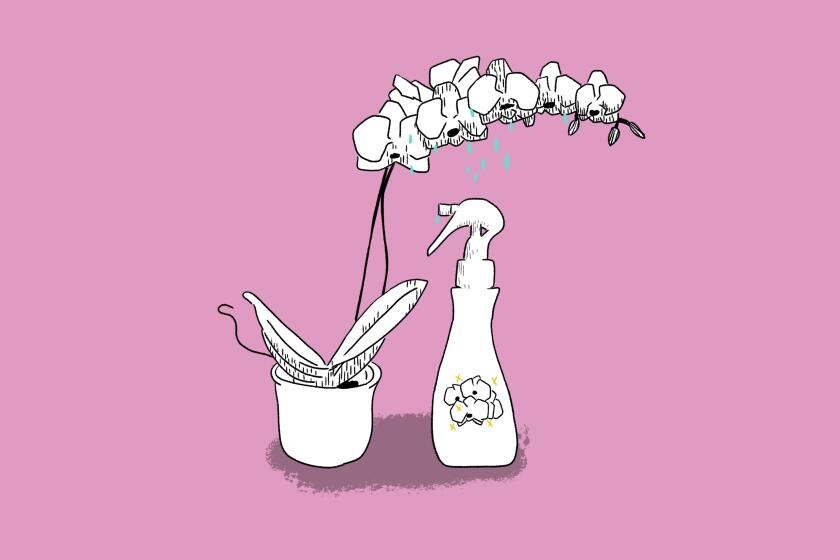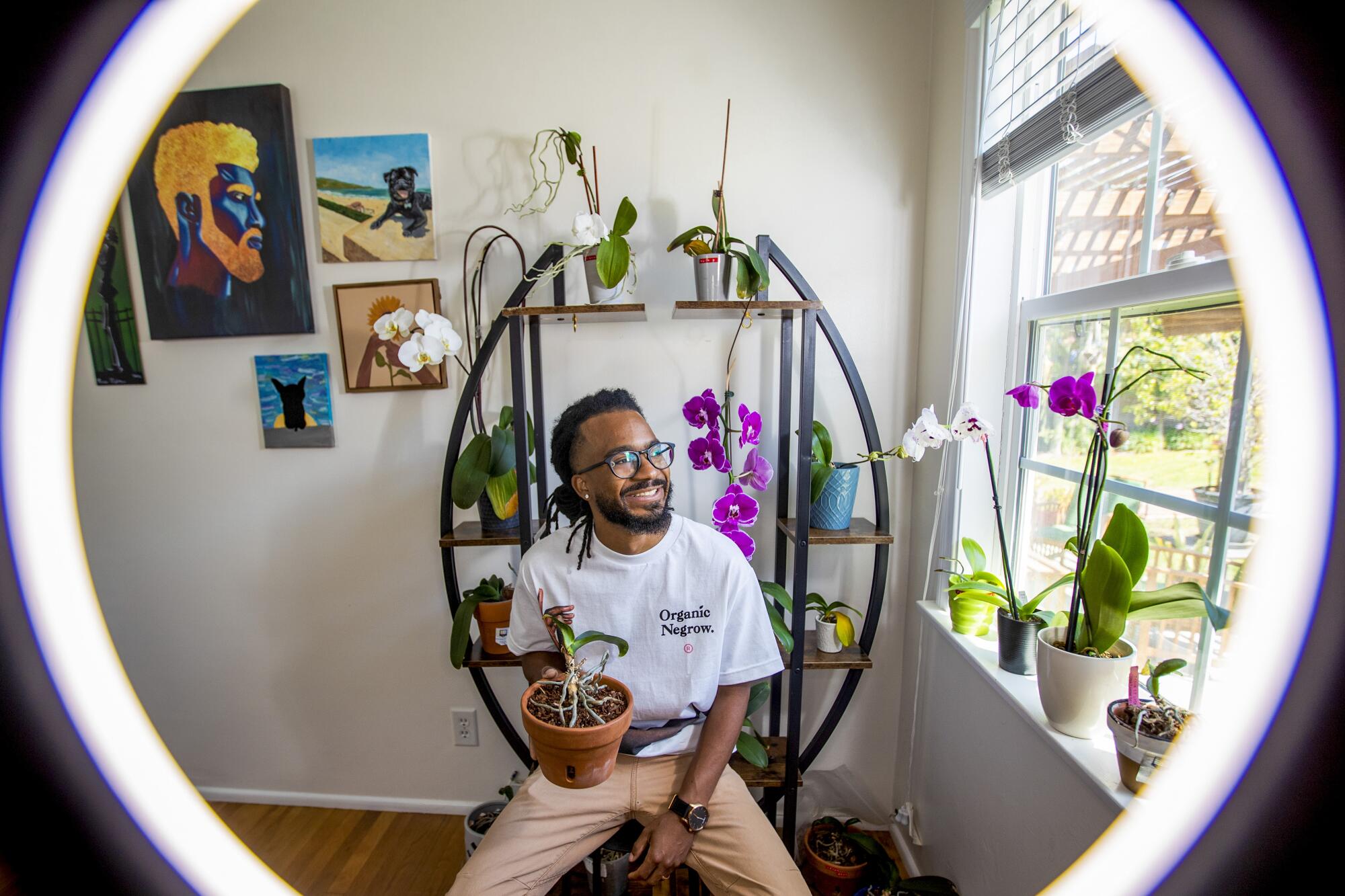
In our Plant PPL series, we interview people of color in the plant world. If you have suggestions for PPL to include, tag us on Instagram @latimesplants.
Like so many superheroes, the Black Thumb discovered his power through tragedy, accident and supreme effort.
It all started when a mild-mannered physical therapist, Terry Richardson, and his wife, Chelsea, welcomed an orchid into their apartment and, through ignorance and neglect, promptly killed it.
Neither one of them had much experience with plants, especially Terry, who at the time thought of himself as someone who couldn’t keep plants alive.
Before that grim day when their first orchid died, Terry and Chelsea received several small succulents as housewarming gifts when they moved into their first apartment in West Torrance. Terry, who grew up in Atlanta in a home filled with fake plants, slowly began to feel confident caring for living greenery with little effort.
“We did the bare minimum, watering them every now and again, and once they grew, repotting them. But it was the positive feedback I needed to think, ‘Hey, I may actually be able to grow something.’ I mean, I have Black thumbs but not a real black thumb because I can actually keep something green and alive.”
Finding your favorite nursery can be thrilling. Here are our picks for the best independently owned plant nurseries near Los Angeles.
All that confidence plummeted, however, after Chelsea brought home an orchid.
“We didn’t know what we were doing,” Terry said. “The orchid didn’t have enough light, we weren’t watering it enough. ... We literally did everything you’re not supposed to do.”
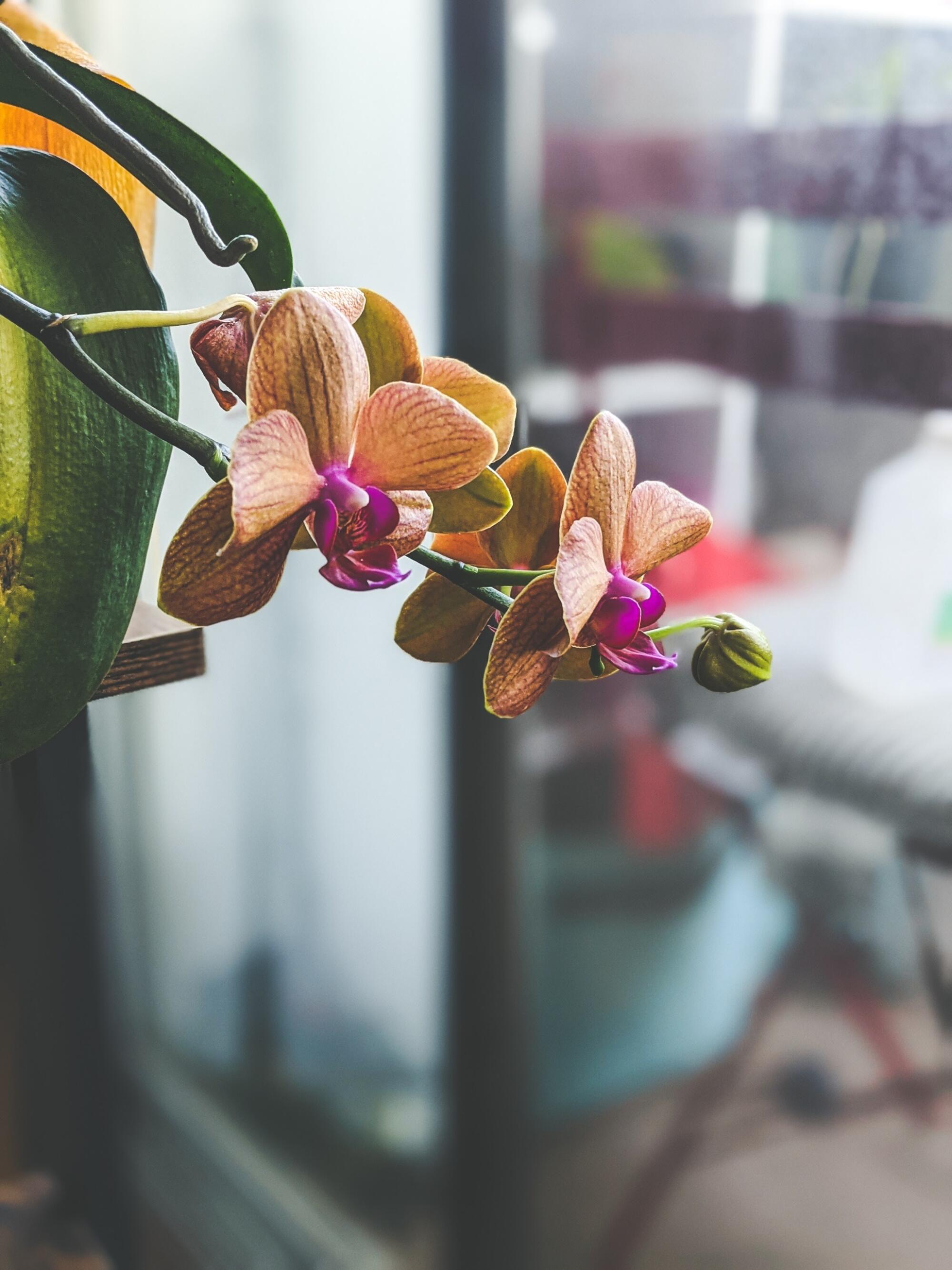
The failure weighed on Terry. He felt guilt and remorse until a few months later, in January 2018, when he went out to empty the trash and discovered an abandoned, half-dead orchid sitting next to the dumpster.
“I thought, ‘Oh cool. I get a second chance!’ So I rescued that orchid, and the only thing I did, at first, was to water it more consistently. I probably didn’t give it the best light, maybe a little better than what I did before, but after 18 months it bloomed, and when I saw the flowers, I named it Penelope.”
And he was hooked.
He chose Penelope because the name “just seemed fitting for her showstopper flowers” — bronzy-apricot petals with a bright fuchsia center (known as the lip). Penelope’s blooms were so gratifying, he vowed to rescue more orchids and started his own Instagram account @orchidwhisperer19 in July 2019 to chronicle what he learned. And over the last three years, more than 2,000 orchid lovers have started following along.
“Seeing Penelope bloom really felt like an accomplishment,” he said. “I had stepped out of my comfort zone and was successful at something that was really hard. I felt like there were good life lessons to learn from plant care, and I thought, ‘How can I re-create that again?’ I started going to the dumpster two or three times a day looking for orchids to rescue so I could have that success again.”
He also took a deep dive into learning about orchids, watching multiple tutorial YouTube videos (a favorite channel was MissOrchidGirl) and rescuing as many Phalaenopsis orchids (aka moth orchids) as he could find. Before long, Terry, Chelsea and their black pug, Larry Oliver Longissimus (named after Chelsea’s favorite muscle), were sharing their small apartment with more than 150 plants in various states of rehabilitation.
Happily, they were able to rent a home in Torrance in late 2021 with a patio and yard that allowed Terry to spread out his plant babies — most of which have their own names, such as the 34th pot of orchids he obtained, named Chuck (aka “Sir Charles” Barkley) and Shaq, after his two favorite NBA players who both wore the number 34, and Norman, a stunning fuchsia-colored orchid named after a former tennis coach, Norman Wilkerson, “a huge mentor in my life who believed in me in a lot of situations when I didn’t believe in myself.”
These days, rescuing orchids has become Terry’s full-time hobby, caring for his plants, researching new information and making videos to share what he’s learned. But fixing living things is Terry’s day job too. He’s a 36-year-old wound care physical therapist at USC’s Keck Medical Center, where he got his physical therapy degree and met his future wife, Chelsea Duncan, who is now a neurologic physical therapist and clinic coordinator at Reactive Therapy and Wellness in Torrance.
“I rescue limbs by day and rescue orchids by night,” Terry joked, but in truth, all that plant tending helped rescue him too. “I don’t know how I would have gotten through the earlier days of the pandemic without plants, especially without orchids,” he said.
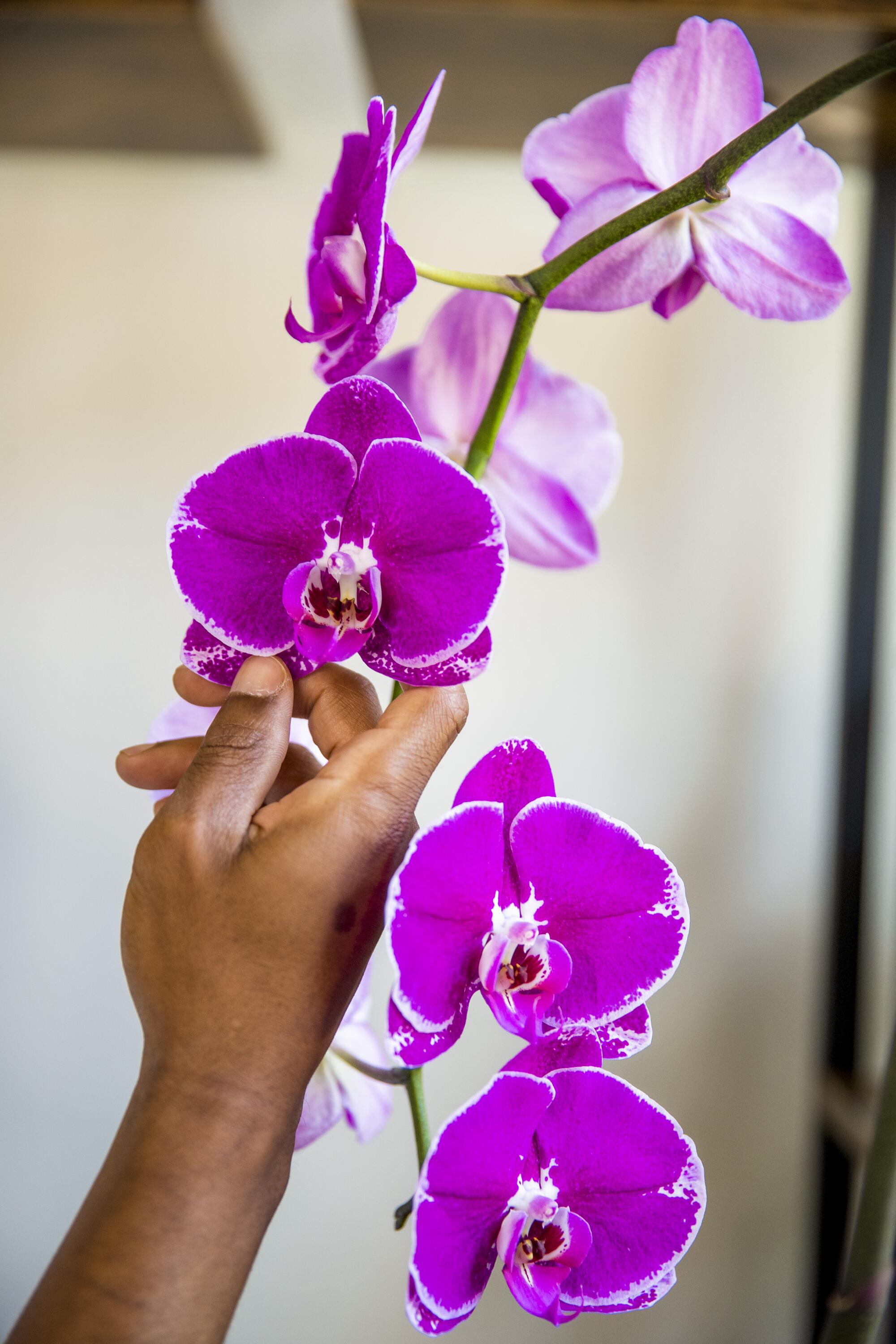
“It was really stressful waking up every day knowing I would have to work directly with COVID patients,” he says. “This was a way for me to come home, spend some time with my wife and dog, and then step out on the balcony and decompress. Being amongst my plants allowed me to reflect, reset, restore, repair ... and also gear up for what would happen next or prepare for the unknown, especially in early 2020.”
The hard part with humans, he says, is that sometimes “You invest in people who aren’t ready for that investment. But working with plants has really helped me with patient care. I can only do so much as a therapist, and then the patients need to take responsibility, but with my plants and my patients, I’m doing my best to help them really reach their full potential and bloom.”
Poachers are stealing wild white sage at an alarming rate from its Southern California habitat and selling it to smudge stick makers. Here’s how to save the native plant.
Over the last year, Terry has branched out in his plant proselytizing, with soothing videos on TikTok (@blackthumbtv) and teaching his first in-person workshop about orchid care at the Flora con Fuego event in early April at the Latinx With Plants store in Boyle Heights, co-sponsored by @thebloomjourney.
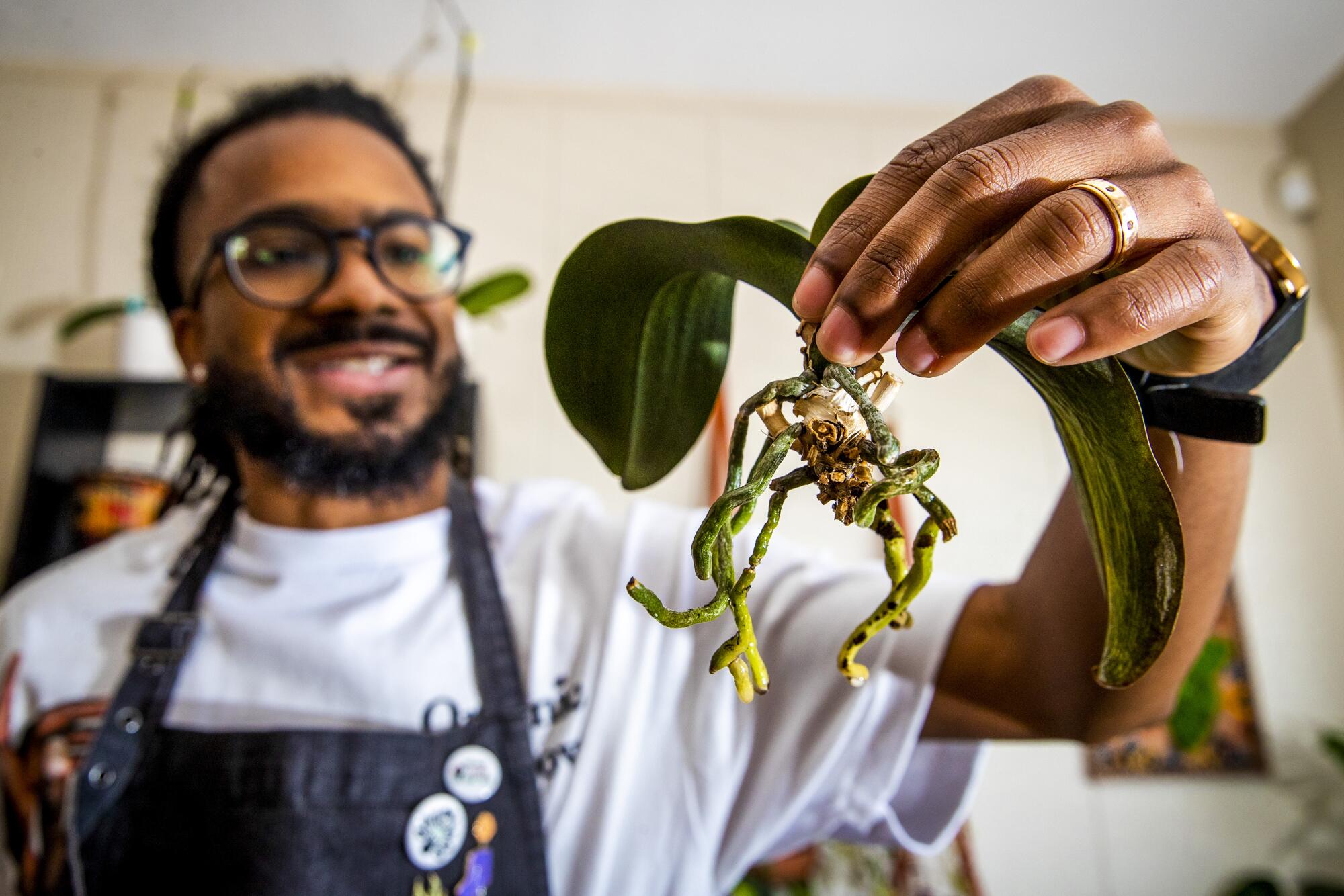
In his videos, it’s easy to see how Terry can convert uncertain orchid owners into devoted plant parents. He’s small, wiry and upbeat, with a wispy beard and a constant smile. He wears his hair in thin dreadlocks, often piled into a messy bun of cascading strands. With his big black-frame glasses, crisp Organic Negrow T-shirts and clear, reassuring explanations, he looks like everyone’s favorite teacher, beloved because he makes learning fun.
Terry says he’d love to make plants his full-time gig someday, but for now, he just wants to help people keep their orchids alive and blooming with some simple tips.
How to care for orchids, which are more resilient than you think
Lots of people get blooming orchids as gifts but then toss the plants once the flowers fade, Terry says. “They’re afraid the plants are too finicky or temperamental to keep alive, but the biggest lesson I’ve learned is that orchids are one of the most resilient plants you can have in your home.”
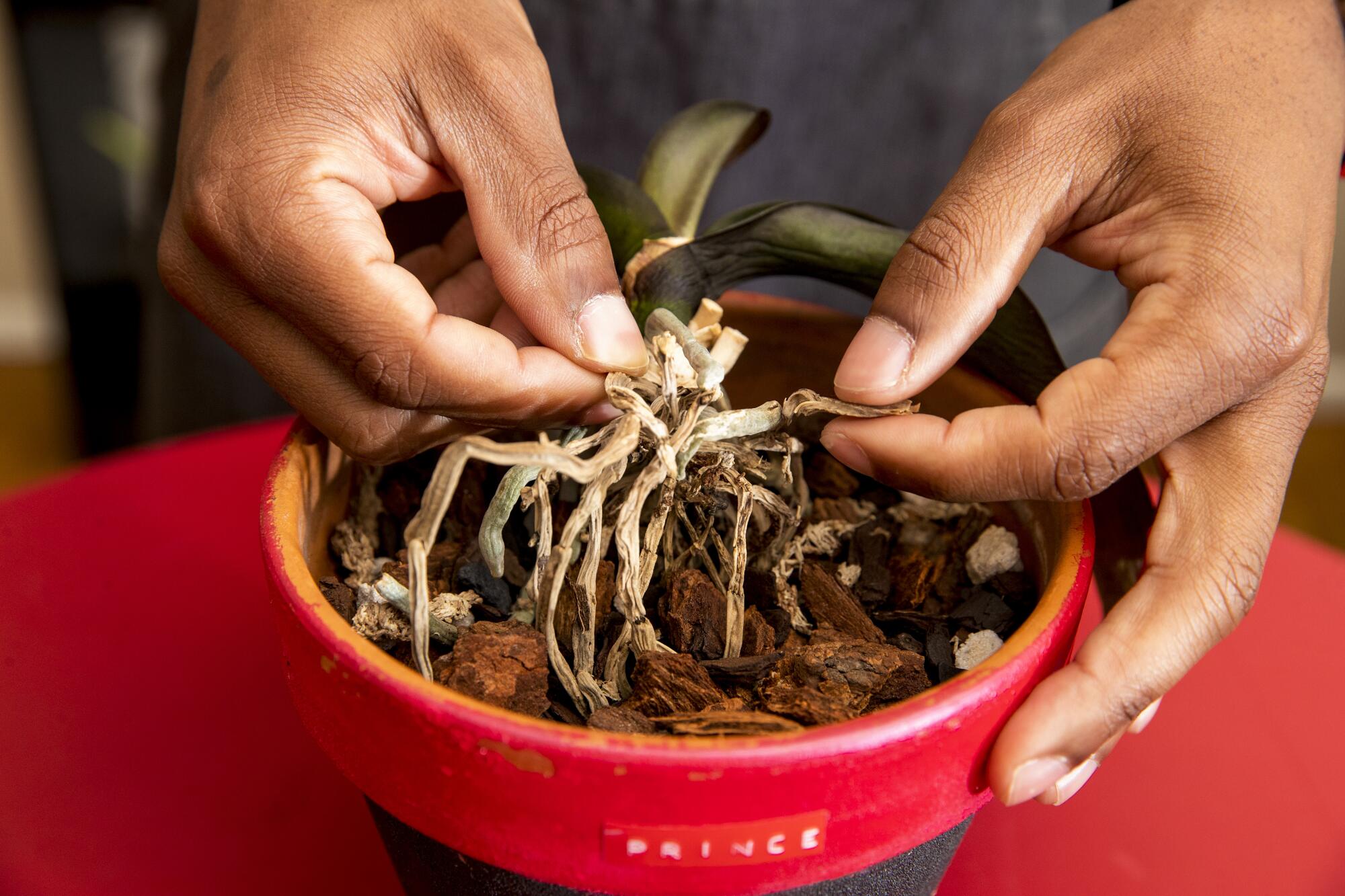
Basically, to thrive and rebloom, orchids need:
- bright indirect lighting (keep them near an east- or south-facing window or shaded patio)
- consistent watering (water them once a week during hot months and maybe every other week when it’s cooler)
- good drainage (water roots growing outside your pot well but avoid getting water in the base of the plant)
- annual repotting
“The reason I’m in love with orchids is you really, really get your money’s worth when they bloom, and they bloom for a long time, some even as long as six months,” Terry says.
Terry recommends repotting your orchids when their roots are cramming up against the sides of the pot and the plant has finished blooming. By then, there’s probably more roots than planting medium, and the nutrients in the medium have been depleted. Moving the plant to a new pot lets you prune off dead roots and leaves, give what remains a thorough cleaning to discourage pests and diseases and provide a little more room for the plant to grow.
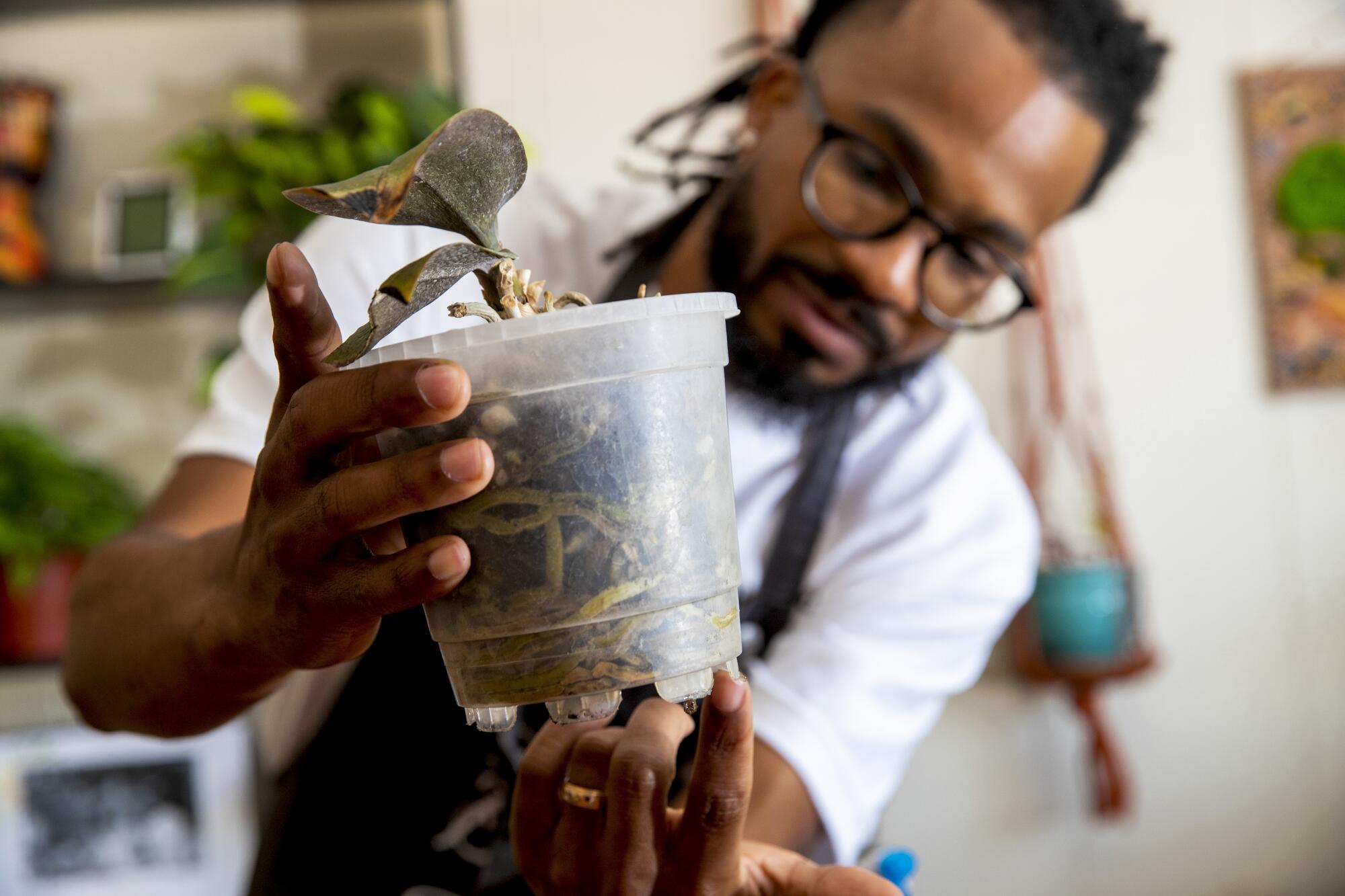
Here are his step-by-step repotting instructions:
1. Assemble your equipment first
- A new pot just an inch or so larger than the one you had before — not too big because orchids like their roots to be cozy, he said. Make sure the new pot has good drainage holes. One idea: Use an inexpensive plastic pot, the kind that hold plants from the nursery, and then slip it into a more decorative container. When it comes time to water, take the plastic pot to the sink, give the plant a good soak and time to thoroughly drain, gently shake off any water that collected in the crown (where the leaves and base of the orchid meet) and then return it to its decorative pot.
- Good sharp hand-pruning shears, small enough to make delicate trims around the roots.
- A bag of your preferred orchid potting medium, typically bark or sphagnum moss. The Black Thumb prefers bark because it drains better, creating fewer chances to overwater and drown your orchid. If the pot is small, he uses a finer bark mix, but for larger pots he uses bigger bark pieces, just because it’s harder to fill up a pot with the smaller bits.
- A large bowl half filled with water.
- A cleaning solution in a spray bottle, made of two parts soapy water and one part 70% isopropyl rubbing alcohol. He typically fills a spray bottle with 16 ounces of water and 8 to 10 squirts of an organic dish soap like Mrs. Meyer’s Clean Day, then adds another 8 ounces of rubbing alcohol.
- Granular slow-release fertilizer. He uses just a capful of Florikan Dynamite 10-10-17 fertilizer for orchids and bromeliads and mixes it in the pot before he adds the orchid. Any slow-release fertilizer is OK, he says, as long as its NPK numbers (nitrogen-phosphorus-potassium) have a higher amount of K (potassium) to encourage long-lasting blooms and overall plant health.
- A watering can and a large container to hold the water as the repotted orchid drains.
Worm composting, or vermicomposting, turns food waste into worm castings that are great for garden soil. Here’s how to start worm composting at home.
2. Gently pull your overgrown orchid from its pot
You may have to squeeze the sides of the pot first to loosen the orchid and its roots. Remove the plant carefully to avoid breaking off roots protruding from the bottom of the pot.
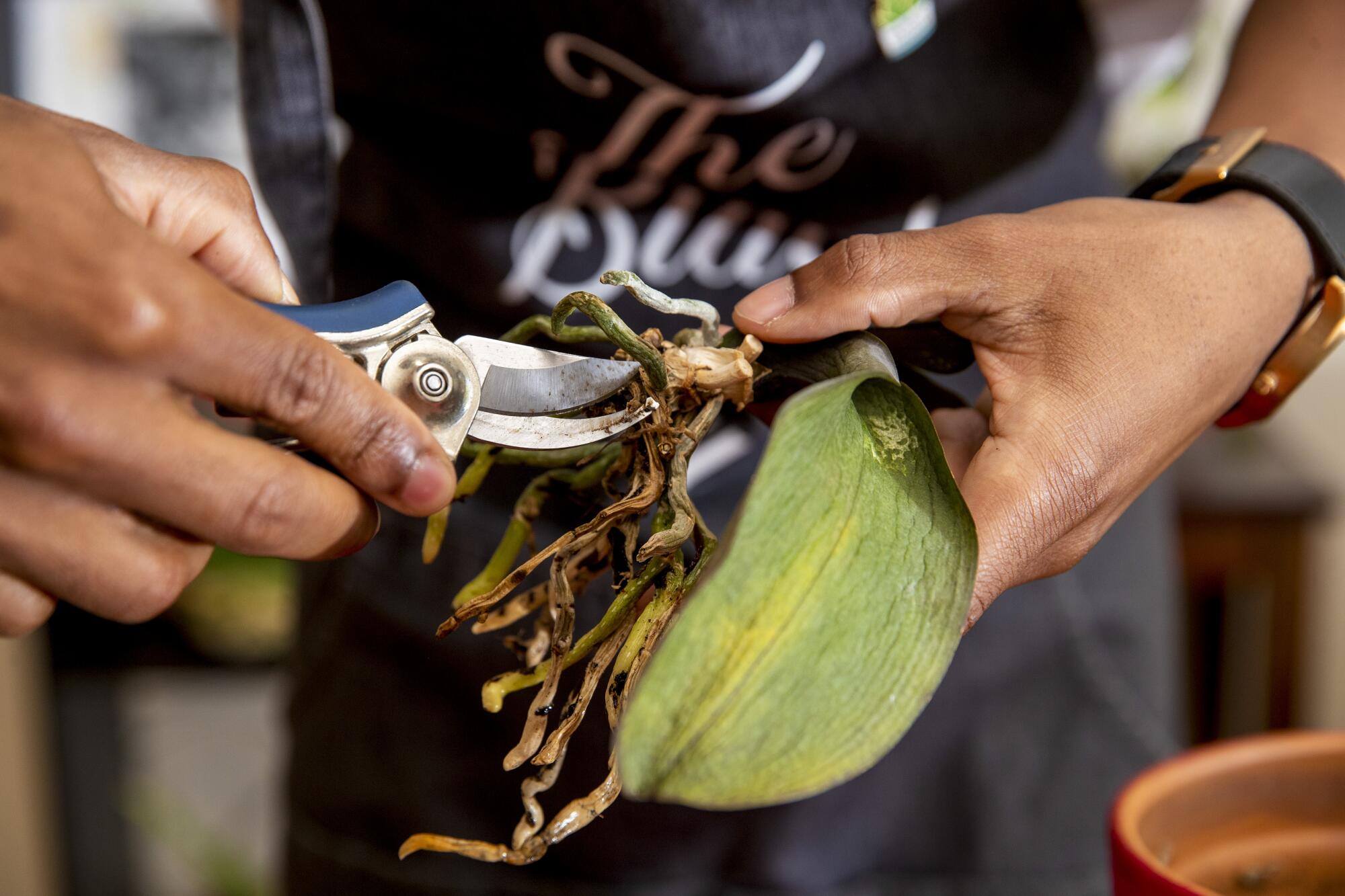
3. Detangle the roots and start trimming dead growth
The roots will likely be a tangled mess, so carefully straighten them, remove any lingering potting medium and then submerge the roots briefly into the bowl of water to determine which are dead and need to be trimmed off.
Healthy roots are plump and usually a brighter green when they come out of the water, he said. Leave those roots and any plump, whitish roots on the plant. Dead roots are a light brown, with the look and flat, squishy feel of wet straw. These are the roots you want to remove. Use sharp pruners but first wipe the blades with rubbing alcohol to make sure you don’t spread any diseases from other plants.
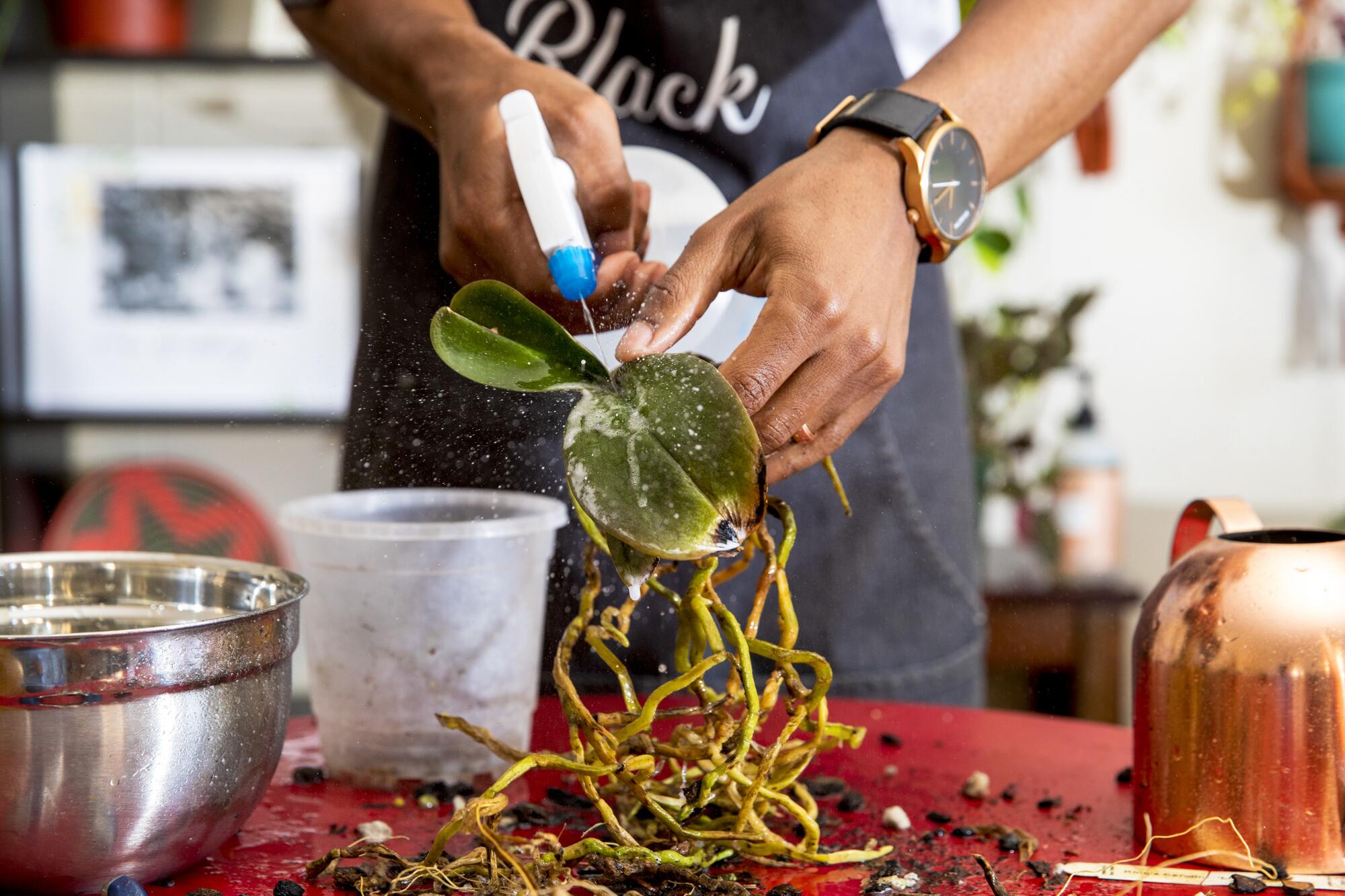
4. Spray and clean your newly trimmed plant
Now is the time to spray down the remaining roots and leaves with the cleaning solution of two parts soapy water and one part rubbing alcohol. Terry leaves the solution on the plant to help deter diseases and pests, but when he is done spraying, he gently shakes the plant upside down to keep water from collecting in the crown.
The No. 1 reason people kill their orchids is they overwater them. An expert offers tips on how to keep them alive.
5. Settle the trimmed orchid into its new pot
Terry fills the pot about a quarter full of the bark potting material and then adds a capful of his granular fertilizer and mixes it well into the bark. Then he gently lowers the roots on top of the bark and centers the plant before adding the rest of the potting material. Don’t worry if the roots aren’t spread out, he says. Orchids like their roots to be “cozy” in the pot, so it won’t hurt them to be somewhat mushed together.
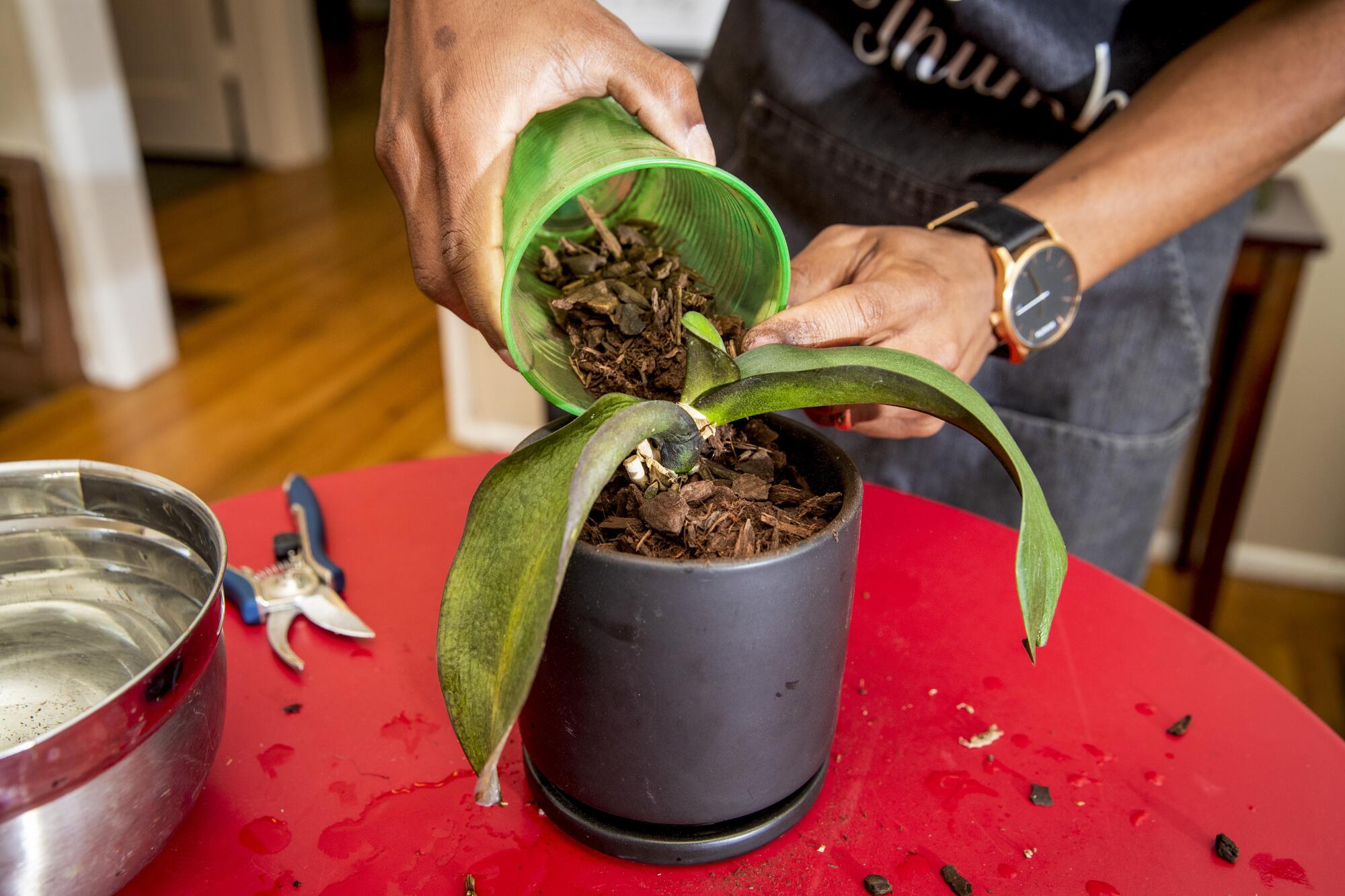
6. Put the newly potted orchid in a bowl and water well
The final step is giving your repotted orchid a good drench. Terry puts the orchid in a bowl to capture any runoff water, but you can also give it a good watering in the sink or a pail; just make sure to water evenly all around the base of the plant, so the excess pours out from the bottom. If you water it in a container, you can save the excess water for another plant. Another watering technique is to put the orchid in a bowl of standing water and let it absorb the water up into the pot. If you choose that technique, give the plant an hour or so in the water before taking it out; don’t leave it too long. Roots, like people, need oxygen to stay alive and don’t do well for extended periods under water.
7. Give the orchid time to settle into its new home
It’s unsettling for any plant to be repotted, and orchids are no exception, so give the plant a little time to settle into its new home. It could take six months to a year before you see new blooms; just be patient, Terry says, with consistent watering and good indirect light. “Patience is definitely a virtue when it comes to orchids.”
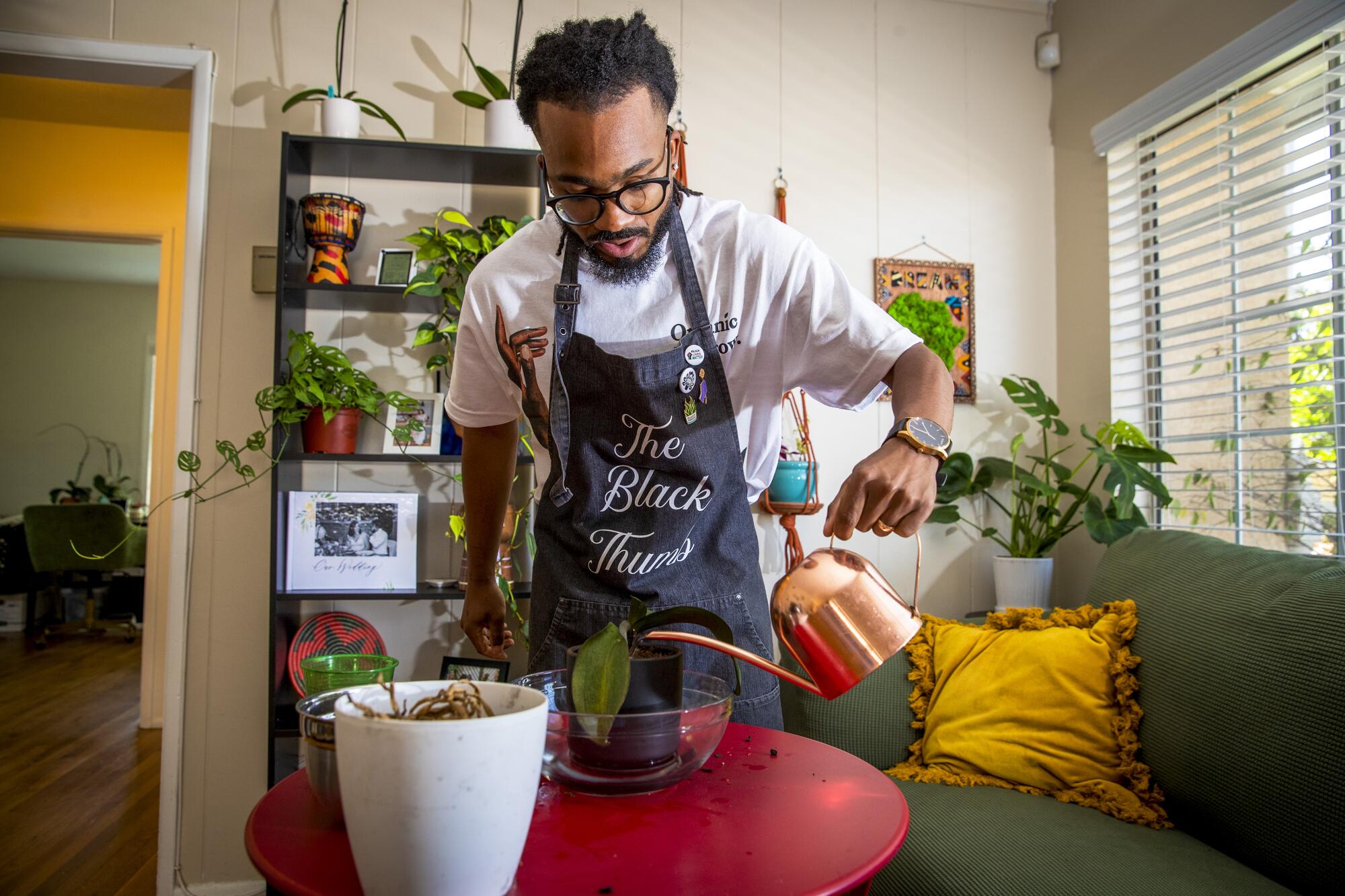
More to Read
Sign up for The Wild
We’ll help you find the best places to hike, bike and run, as well as the perfect silent spots for meditation and yoga.
You may occasionally receive promotional content from the Los Angeles Times.



